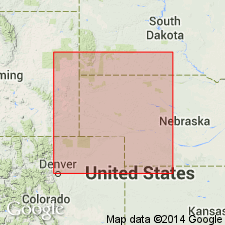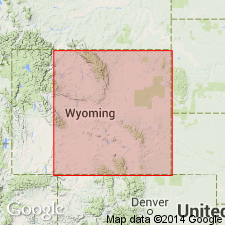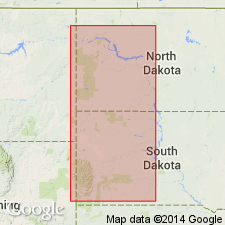
- Usage in publication:
-
- Reclamation group
- Modifications:
-
- Named
- Dominant lithology:
-
- Limestone
- Shale
- AAPG geologic province:
-
- Chadron arch
- Denver basin
Summary:
Named Reclamation group. These rocks were previously assigned to Division V of Hartville formation [not used in this report] in earlier reports. Recognized in Hartville uplift area, Wyoming, and Hot Springs area, South Dakota, on the Chadron arch. Composed of alternating beds of dark-gray and maroon, mottled dense limestone; and dark maroon and green polka dot, thin bedded shale with limestone nodules. Limestone beds are fossiliferous. Ranges from 72 to 87 feet thick. Overlies Fairbank formation (new); underlies Roundtop group (new). Correlates with part of Cherokee group of Des Moines age. Age is Pennsylvanian. Report includes measured sections.
Type locality: Reclamation Hill, sec. 27, T. 27 N., R. 66 W., Platte Co., WY, in the Denver basin. Named from Reclamation Hill.
Source: Modified from GNU records (USGS DDS-6; Denver GNULEX).

- Usage in publication:
-
- Reclamation group
- Modifications:
-
- Overview
- Areal extent
- AAPG geologic province:
-
- Powder River basin
Summary:
Combined with overlying Roundtop group to form a subdivision of Hartville formation in the subsurface, along the east side of Powder River basin in Niobrara, Weston, Crook, and Campbell Counties, Wyoming. /Reclamation-Roundtop groups overlie Fairbank formation and underlie /Meek-Wendover and Hayden groups, all considered subdivisions of the Hartville formation. Correlated with Amsden formation in the Bighorn Mountains, Wyoming. Age is Early Pennsylvanian (Atokan).
[The use of a hyphen between undifferentiated [groups] has not been considered proper notation since 1933 (see CSN, Art. 13a, p. 437-438). Where the [groups] have not been separated in the field, it is considered proper notation to add the word "and", "undifferentiated", "included", etc.; and list [groups] in order of age (youngest first).]
Source: Modified from GNU records (USGS DDS-6; Denver GNULEX).

- Usage in publication:
-
- Reclamation group
- Modifications:
-
- Overview
- Areal extent
- AAPG geologic province:
-
- Williston basin
Summary:
Used in formational sense in Williston basin. Consists of argillaceous limestone interbedded with thin, red and green shales. Mapped in subsurface, in combination with overlying Roundtop and underlying Fairbank(?) [formation]. Formerly included near the top of Amsden formation by the North Dakota Geological Society (1954, Stratigraphy of the Williston basin). Age is probably Early Pennsylvanian (Atokan); see correlation chart (table 2, p. 151).
Source: Modified from GNU records (USGS DDS-6; Denver GNULEX).
For more information, please contact Nancy Stamm, Geologic Names Committee Secretary.
Asterisk (*) indicates published by U.S. Geological Survey authors.
"No current usage" (†) implies that a name has been abandoned or has fallen into disuse. Former usage and, if known, replacement name given in parentheses ( ).
Slash (/) indicates name conflicts with nomenclatural guidelines (CSN, 1933; ACSN, 1961, 1970; NACSN, 1983, 2005, 2021). May be explained within brackets ([ ]).

